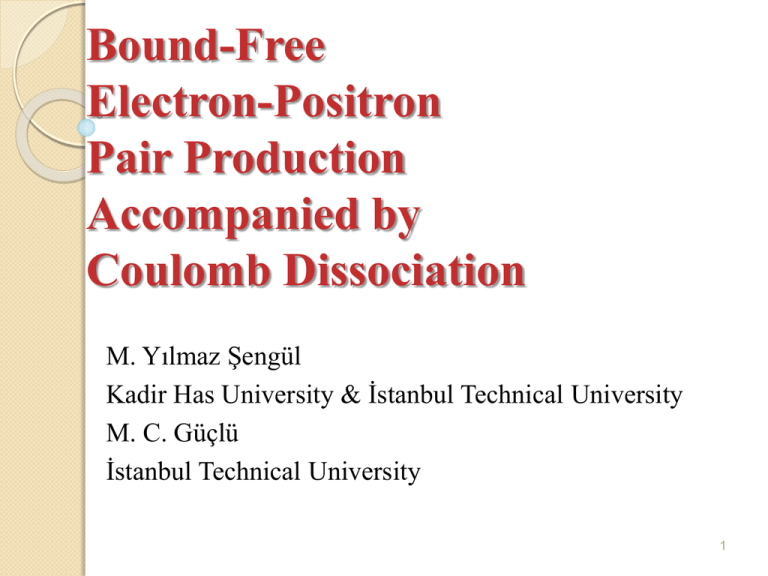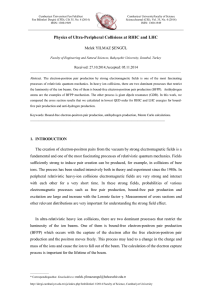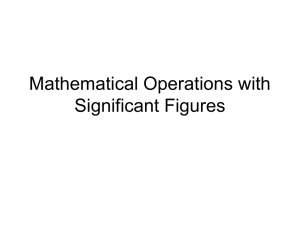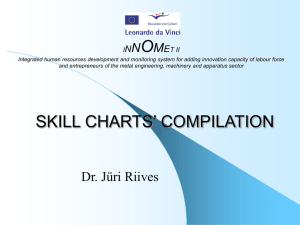Bound-Free Electron-Positron Pair Production
advertisement

Bound-Free Electron-Positron Pair Production Accompanied by Coulomb Dissociation M. Yılmaz Şengül Kadir Has University & İstanbul Technical University M. C. Güçlü İstanbul Technical University 1 - INTRODUCTION * Free Electron-Positron Pair Production * Bound-Free Electron-Positron Pair Production * Pair Production by Nuclear Dissociation - Free Pair Production - Bound-Free Pair Production - FORMULATION * Formulation for Free Electron-Positron Pair Production * Cross Section Calculations for Bound-Free Electron-Positron Pair Production * Other Methods for Bound-Free Electron-Positron Pair Production Cross Section Calculations * Impact Parameter Dependent Bound-Free Electron-Positron Pair Production * Comparison of the Impact Parameter Dependent Bound-Free Electron-Positron Pair Production Calculations with the Other Methods * Bound-Free Electron-Positron Pair Production Cross Section Calculations by Coulomb Dissociation - RESULTS * Cross Section Results for Bound-Free Electron-Positron Pair Production by Giant Dipole Resonance 2 INTRODUCTION *Free Electron-Positron Pair Production Z1 Z 2 Z1 Z 2 e e Ion 1 e e Ion 2 time Pair Production Emits photon Emits photon 3 Z e+ e- Z * Bound-Free Electron-Positron Pair Production Z1 Z 2 ( Z1 e )1s1 / 2 ,... Z 2 e Fig-1: Pair production with capture in relativistic heavy ion colliders [1]. 5 Z e+ e- Z Z-1 e- * Pair Production by Nuclear Dissociation - Free Pair Production; Z1 Z2 Z Z e e * 1 * 2 Fig-2: Free pair production accompanied by GDR in a relativistic heavy ion collisions. 7 n n n n n n e+ e- n n n n n n 8 - Bound-Free Pair Production; Z1 Z 2 ( Z1* e )1s1 / 2 ,... Z 2* e Fig-3: BFPP accompanied by GDR in a relativistic heavy ion collisions. 9 n n n n n n e+ e- n n n n e- n n 10 - FORMULATION * Formulation for Free Electron-Positron Pair Production Semi-Classical Action Integral S d x (t ) : L0 ( x ) LI ( x ) LEM ( x ) : (t ) 4 Free Fermion Lagrangian Density L0 ( x ) ( x )( i m )( x ) Interaction Lagrangian Density LI ( x ) e( x ) ( x ) A ( x ) EM Lagrangian Density LEM Fμν(x)F (x) 1 4 μν 11 LQED L0 LI LEM Ψ( i m)Ψ eΨγμ ΨAμ 14 Fμν (x)F μν (x) Dirac wave-function of electrons&positrons A Electromagnetic vector potential F A ( x ) A ( x ) Electromagnetic field tensor 12 Equations of Motion ( i A ( x )) 1 ( x ) 0 H ( x) K (t , t ) i t K (t , t ) ' ' H ( x) H 0 ( x) V ( x) H 0 ( x) i . 0 m V ( x) . A( x) A0 ( x) 13 Perturbative Expansion t K t , K 0 t , (i) d K 0 t , V K 0 , t (i) 2 d d K 0 t , V K 0 , V K 0 , ... K 0 ( t ,t ) e ' iH0 ( t t' ) 14 4-Vector Potentials of Colliding Ions A A (1) A ( 2 ) b ( q0 qz ) 0 2 2 A ( 1 ) 8 Z 2 exp[iq . ] 2 2 2 qz ( qx q y ) 2 A (1 ) A (1 ) z 0 A (1 ) A ( 2 ) 0 x x A (1 ) A ( 2 ) 0 y y 15 The time-evolved vacuum state in the interaction picture; S 0 lim K 0 ( 0,t )K ( t ,t ) 0 t Total cross section for electron-positron pair production; d b 2 k 0 q 0 () k S () q 2 16 Second order terms for direct and crossed diagrams; k( ) S q( ) ( i )2 d d ' k( ) K 0 ( 0, )K 0 ( , ) [ V1( )K 0 ( , ' )V 2( ' ) V2 ( )K 0 ( , ' )V1( ' )] K 0 ( ' , )K 0 ( ,0 ) q( ) S S12 S21 17 * Cross Section Calculations for Bound-Free Electron-Positron Pair Production Captured electron (Darwin) wave function [2,3]; ψ () i 1 . uΨ non r ( r ) 2m 1 Z Ψ non r ( r ) aH 3/ 2 e Zr / aH i 1 Z () ψ ( r ) 1 . u 2m aH 3/ 2 e Zr / aH 18 Positron (Sommerfeld-Maue) wave-function [1,4]; ψ N e N 2 ψ ' N () q N [e a / 2 i q.r u q ψ ] (1 ia ) 2a 2a e 1 () ' Ze a v 2 Distortion (correction) term due to the large charge of the ion. Normalization constant. 19 Fig-4: Lowest-order Feynman diagrams for the pair production of a bound-free electron-positron pair in heavy-ion collisions: (i) direct and (ii) crossed diagrams for the simultaneous capture of the electron into a bound state of target (T) ion. In the figure, 1 and 2 represents the two ions, and q is the momentum of the positron [5]. 20 S- transition matrix element for direct diagrams; term of Feynman ψ ( ) S12 ψq( ) iN 1 Z 2 aH 3/ 2 2 d p (2 )2 e i ( p q ). b 2 F ( p : 1 ) F ( p q : 2 ) q ( p : ) 21 Scalar parts of the fields as associated with ions 1 and 2; F ( p : 1 ) 4 Z e 2 Z2 12 2 2 2 p aH F ( p q : 2 ) 4 Ze 2 2 2 2 2 ( p q ) 2 2 22 The virtual photons frequency of ion 1 & ion 2; 1 2 E () Eq () qz 2 Eq () E () 2 qz pz ( pz qz ) 23 Transition amplitudes; 1 . p q ( p : ) 1 () () 2m E Eq s p (s) q z Ep ( ) 2 2 u (1 Z ) u( sp) u( s ) (1 Z ) u( q ) p 24 After making all the simplifications, the final form of the BFPP cross section can be expressed as; d b ψ 2 () Sψ q 0 N 4 2 2 3 2 d qd p 1 Z 3 ( ) 5 aH q (2 ) () q 2 2 () (q : p ) () (q : q p ) Some proper products of the transition amplitudes and scalar parts of the fields as associated with ions 1 and 2. () ( q : p ) F ( p : 1 ) F ( p q : 2 ) q ( p : ) () (q : q p ) F ( p q : 2 ) F ( p : 1 ) q (q p : ) 25 * Other Methods for Bound-Free Electron-Positron Pair Production Cross Section Calculations * Bertulani and Baur [1988] * Rhoades-Brown, Bottcher and Strayer [1989] * Baltz, Rhoades-Brown and Weneser [1991-94] BFPP A ln B BFPP 11.2 ln 24 (barn) Au Au BFPP 14.3ln 31 (barn) Pb Pb 26 * Impact Parameter Dependent Bound-Free Electron-Positron Pair Production [6,7] d BFPP dq q b J 0 ( qb ) (q) db 0 ( q ) 8 2 2 1 Z N aH 3 2 dqz d 2 Kd 2 Q d q ( 2 )7 q 0 1 1 F ( Q q ); F K ; ( Q q ); 1 2 q 2 2 1 F ( Q q ); F K ; K ; 1 2 q 2 1 1 F ( Q q ); F K ; ( Q q ); 1 2 q 2 2 1 F ( Q q ); F K ; K ; 1 2 q 2 27 d BFPP ab a q (0) dq q b J 0 ( qb ) e PBFPP( b ) BFPP 2 2 3/ 2 db ( a b ) 0 (q) (0) eaq BFPP eaq Fig-5: The function ( q ) / ( 0 ) is calculated . The points show the results of the Monte Carlo calculations and the smooth curve is our fit for these points. The slope of this function gives the value of a as 1.35C . 28 Comparison of the Impact Parameter Dependent Bound-Free Electron-Positron Pair Production Calculations with the Other Methods * 178.246 P(b) (1.72134 1010 b 4 )1 / 2 RHIC-Au+Au P(b) 228.807 (1.72134 1010 b 4 )1 / 2 RHIC-Pb+Pb PBFPP ( b ) BFPP a 2 ( a 2 b 2 )3 / 2 Fig-6: Probability of positron production with gold beams at RHIC as a function of b; the solid line shows our work and the dashed line shows the work of Baltz [7]. 29 * Bound-Free Electron-Positron Pair Production Cross Section Calculations by Coulomb Dissociation PBFPP (b) BFPP PC (1n ) (b) P 1 C (1n ) PC1 (b) S / b 2 a 2 ( a 2 b2 )3 / 2 (b) e PC1 ( b ) the probability of bound-free electron-positron pair production probability; the probability of GDR excitation in one ion; the probability of a simultaneous nuclear excitation as a function of impact parameter; 2 2 Z 3 N S 5.45 105 Z 3 NA2 / 3 fm2 AmN GDR 30 2 db b P ( b ) P BFPP C (1n ) ( b) GDR BFPP 2 bmin the total cross section for BFPP with mutual nuclear excitation; PC ( Xn ) (b) 1 e ( PC1 ( Xn ) ( b )) the probability for at least one Coulomb excitation; GDR BFPP 2 db b PBFPP (b)PC2( Xn ) (b) bmin the total cross section for BFPP with mutual nuclear excitation at least one Coulomb excitation; 31 - RESULTS * Cross Section Results for Bound-Free ElectronPositron Pair Production by Giant Dipole Resonance Untagged (barn) Tagged(1n1n) (mbarn) Tagged(XnXn) (mbarn) Au+Au-RHIC-Free [7] 34000 1630 1980 Pb+Pb-LHC-Free [7] 212000 10200 12400 Au+Au-RHIC-BFPP [7] 94,5 4,5 5,5 Au+Au-RHIC-BFPP-Baltz [8] 88,8 1,1 1,4 Pb+Pb-LHC-BFPP [7] 202 9,7 11,7 Table-1: Integrated cross sections for Au+Au collision at RHIC energies and for Pb+Pb collisions at LHC energies for free and bound-free pair production. 32 Untagged (barn) Tagged(1n1n) (mbarn) Tagged(XnXn) (mbarn) Pb+Pb-RHIC [7] 123 5,92 7,18 Pb+Pb-RHIC-Baltz [8] 113 1,44 1,74 Table-2: Integrated cross sections for Pb+Pb collisions at RHIC energies by using our calculations and for the same collision at RHIC energies by using the calculations of Baltz [7]. 33 Fig-7: The probability of positron pair production with (a) gold beams at RHIC and (b) lead beams at the LHC as a function of b with XnXn (dashed line) and 1n1n (dotted line) and without nuclear excitation [7]. 34 Fig-8: The differential cross section as function of energy of the produced positrons is shown in the graph (a) for RHIC and (b) for LHC. And the differential cross section is shown as function of the longitudinal momentum of the produced positrons in the graph (a) for RHIC and (b) for LHC [7]. 35 Fig-9: The differential cross section as function of transverse momentum of the produced positrons is shown in the graph (a) for RHIC and (b) for LHC. And the differential cross section is shown as function of the rapidity of the produced positrons in the graph (a) for RHIC and (b) for LHC [7]. 36 Finally; 1) 2) 3) 4) 5) By using semi-classical two photon method, we have obtained bound-free electron-positron pair production cross section. By using this method, we have calculated impact parameter dependent boundfree electron-positron pair production probability. We have calculated the cross section of bound-free electron-positron pair production accompanied by giant dipole resonance for the first time in the literature. We have obtained the differential cross section of produced positrons as a function of energy, transverse momentum, longitudinal momentum and rapidity for the bound-free electron-positron pair production accompanied by giant dipole resonance. We are planning to implement this method to calculate the cross section of different particles such as mesons, heavy leptons and anti-hydrogen. 37 - REFERENCES 1) C.A. Bertulani, D. Dolci, Nucl. Phys. A 683, 635(2001). 2) V.B.Berestetskii, E.M. Lifshitz, L.P. Pitaevskii, Relativistic Quantum Field Theory (Pergamon Press, NewYork, 1979). 3) J. Eichler, W.E. Meyerhof, Relativistic Atomic Collisions (Academic Press, California, 1995). 4) C.A. Bertulani, G. Baur, Phys. Rep. 163, 299 (1988). 5) M.J. Rhoades-Brown, C. Bottcher, M.R. Strayer, Phys. Rev. A 40, 2831 (1989). 6) M.C. Güçlü, Nucl.Phys. A 668, 149 (2000). 7) M.Y. Şengül, M.C. Güçlü, Phys. Rev. C 83, 014902 (2011). 8) A.J. Baltz, M.J. Rhoades-Brown, J. Weneser, Phys. Rev. E 54, 4233 (1996). THANKS FOR YOUR ATTENTION! 38







